
Surveillance aircraft are aircraft used for surveillance. They are primarily operated by military forces and government agencies in roles including intelligence gathering, maritime patrol, battlefield and airspace surveillance, observation, and law enforcement.

A barrage balloon is a type of airborne barrage, a large uncrewed tethered balloon used to defend ground targets against aircraft attack, by raising aloft steel cables which pose a severe risk of collision with hostile aircraft, making the attacker's approach difficult and hazardous. Early barrage balloons were often spherical. The kite balloon, having a shape and cable bridling that stabilizes the balloon and reduces drag, could be operated at higher wind speeds than a spherical balloon. Some examples carried small explosive charges that would be pulled up against the aircraft to ensure its destruction. Barrage balloons are not practical at higher altitudes due in large part to the cable's weight.
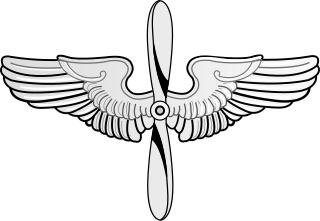
The United States Army Air Service (USAAS) was the aerial warfare service component of the United States Army between 1918 and 1926 and a forerunner of the United States Air Force. It was established as an independent but temporary branch of the U.S. War Department during World War I by two executive orders of President Woodrow Wilson: on May 24, 1918, replacing the Aviation Section, Signal Corps as the nation's air force; and March 19, 1919, establishing a military Director of Air Service to control all aviation activities. Its life was extended for another year in July 1919, during which time Congress passed the legislation necessary to make it a permanent establishment. The National Defense Act of 1920 assigned the Air Service the status of "combatant arm of the line" of the United States Army with a major general in command.
This is a list of aviation-related events during the 19th century :

The Deutsche Luftstreitkräfte – known before October 1916 as Die Fliegertruppen des deutschen Kaiserreiches – was the air arm of the Imperial German Army. In English-language sources it is usually referred to as the Imperial German Air Service, although that is not a literal translation of either name. German naval aviators of the Marine-Fliegerabteilung were an integral part of the Imperial German Navy. Both military branches operated aeroplanes, observation balloons and airships.

The Austro-Hungarian Aviation Troops or Imperial and Royal Aviation Troops were the air force of the Austro-Hungarian Empire until the empire's demise in 1918; it saw combat on both the Eastern Front and Italian Front during World War I.

Balloons and kites were the first inventions used in aerial warfare and their primary role was reconnaissance. Balloons provided a reliable and stable means of elevating an observer high over the battlefield to obtain a birds-eye view of troop positions and movements. An early instrument of aerial intelligence collection, they were also useful for creating accurate battlefield maps, an important ingredient for battlefield success. Incendiary balloons also have a long history. The incendiary balloons carry hot air or something that can catch fire to destroy enemy territory. They could also hold small bombs for combat. The history of military ballooning dates back to the late 18th century, when the Montgolfier brothers, Joseph-Michel and Jacques-Étienne, first demonstrated the potential of hot-air balloons for military use. The first recorded military use of balloons was during the French Revolutionary Wars, when the French military used balloons to gather intelligence on the movements of the enemy. Balloons were also used during the American Civil War, where they were used for reconnaissance and communication. Balloons had a decline after several incidents in the interwar period.

An observation balloon is a type of balloon that is employed as an aerial platform for gathering intelligence and spotting artillery. The use of observation balloons began during the French Revolutionary Wars, reaching their zenith during World War I, and they continue in limited use today. Synonyms include espionage balloon, reconnaissance balloon, spy balloon, and surveillance balloon.
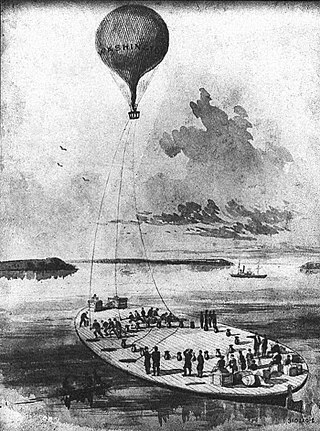
A balloon carrier or balloon tender was a ship equipped with a balloon, usually tied to the ship by a rope or cable, and usually used for observation. During the second half of the 19th century and the early 20th century, these ships were built to have the furthest possible view of the surrounding waters. After several experiments, the type became formalized in the early 1900s, but was soon to be superseded by the development of seaplane carriers and regular aircraft carriers at the beginning of World War I.

A kite balloon is a tethered balloon which is shaped to help make it stable in low and moderate winds and to increase its lift. It typically comprises a streamlined envelope with stabilising features and a harness or yoke connecting it to the main tether and a second harness connected to an observer's basket.

A tethered, moored or captiveballoon is a balloon that is restrained by one or more tethers attached to the ground so it cannot float freely. The base of the tether is wound around the drum of a winch, which may be fixed or mounted on a vehicle, and is used to raise and lower the balloon.

Aerial reconnaissance is reconnaissance for a military or strategic purpose that is conducted using reconnaissance aircraft. The role of reconnaissance can fulfil a variety of requirements including artillery spotting, the collection of imagery intelligence, and the observation of enemy maneuvers.

A kytoon or kite balloon is a tethered aircraft which obtains some of its lift dynamically as a heavier-than-air kite and the rest aerostatically as a lighter-than-air balloon. The word is a portmanteau of kite and balloon.

Henry Post Army Airfield is a military use airport located at Fort Sill in Comanche County, Oklahoma, United States. This military airport is owned by United States Army. Established as Post Field in 1917, it was one of thirty-two Air Service training camps established after the United States entry into World War I in April 1917.
Aerial reconnaissance using heavier-than-air machines was an entirely new science that had to be improvised step-by-step. Early operations were low-level flights with the pilot often dismounting from the plane to report verbally to the nearest officers. Photographic support was urgently developed, initially requiring a full-time photographer on board to handle the heavy, awkward equipment. The interpreting of aerial images was an important new speciality, essential for accurate mapping. By 1915, air-to-ground radio was in use for reconnaissance pilots.

The 2nd Special Operations Squadron is an Air Force Reserve Command unit, assigned to the 919th Special Operations Wing. Stationed at Hurlburt Field, Florida, the unit operates General Atomics MQ-9 Reaper remotely piloted vehicles.
The Service technique de l'aéronautique (STAé) was a French state body responsible for coordinating technical aspects of aviation in France. Formed in 1916 as the Section technique de l'aéronautique the STAé continued until 1980 when its functions were distributed among other French governmental bodies, including the Service technique des programmes aéronautiques (STPA), Service technique des télécommunications et des équipements aéronautiques (STPA) and the Service central de la production, des prix et de la maintenance (SCPM).
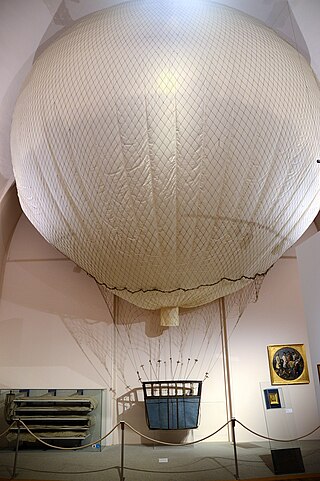
Chalais-Meudon is an aeronautical research and development centre in Meudon, to the south-west of Paris. It was originally founded in 1793 in the nearby Château de Meudon and has played an important role in the development of French aviation. Starting with the development and production of balloons, the site has been a centre of aviation development, mainly but not exclusively military, ever since. Many famous French aircraft designers and engineers worked here or used its resources, such as hangars, wind tunnels, and laboratories to further their activities, and the site continues as an aerospace research hub into the 21st century.
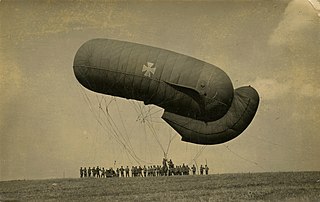
Parseval-Sigsfeld kite balloon was a type of non-rigid military observation balloon, designed in 1898 by August von Parseval and Hans Bartsch von Sigsfeld. Its aerodynamic shape and the air capsule ensured a stable position thanks to the force of the wind, in a similar way to how kites are stabilized; for this reason it was known as the kite balloon.
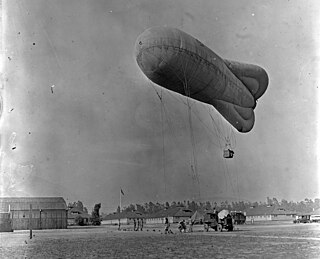
Caquot kite balloon was a type of non-rigid military observation balloon, designed in 1915 by Albert Caquot. The type became widely used by Allied forces in World War I warfare for multiple observation or naval defence uses and later also as a anti-aircraft barrage balloon.
















